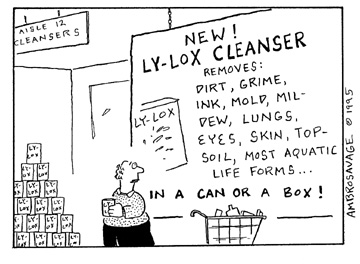WAfreepress@gmail.com
Oh, Those Silly Natural Cleaning Products
UW's Enviro Studies Program Gets Pulped
So what if many household cleaners contain bleach, lye or acid which can irritate your lungs, corrode your skin and blind you. To prove their point, company officials conducted "comparison tests" of their own products - including Clorox bleach, Tilex Soap Scum Remover and 409 Glass and Surface Cleaner, among others - with home substitutes such as vinegar and baking soda.
To prove their point, company officials conducted "comparison tests" of their own products - including Clorox bleach, Tilex Soap Scum Remover and 409 Glass and Surface Cleaner, among others - with home substitutes such as vinegar and baking soda.
If an environmental studies program gets axed in the tangled bramble of academia and no one is there to hear it fall, does it really make any noise? Well, UW students and faculty can wax philosophical on that one all summer long, but it won't change the fact that the university's Institute for Environmental Studies has come crashing down like so much old growth.
[Home]
[This Issue's Directory]
[WFP Index]
[WFP Back Issues]
[E-Mail WFP]





Contents on this page were published in the June/July, 1995 edition of the Washington Free
Press.
WFP, 1463 E. Republican #178, Seattle, WA -USA, 98112. -- WAfreepress@gmail.com
Copyright © 1995 WFP Collective, Inc.
